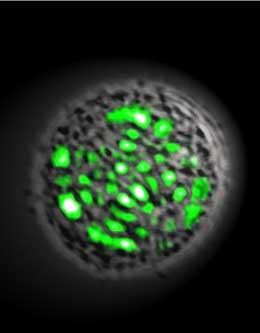 Scientists have for the first time created laser light using living biological material: a single human cell and some jellyfish protein.
Scientists have for the first time created laser light using living biological material: a single human cell and some jellyfish protein."Lasers started from physics and are viewed as engineering devices," says Seok-Hyun Yun, an optical physicist at Harvard Medical School and Massachusetts General Hospital in Boston, who created the 'living laser' with his colleague Malte Gather. "This is the first time that we have used biological materials to build a laser and generate light from something that is living." The finding is reported today in Nature Photonics
Building a laser requires two things: a lasing material that amplifies light from an external source (a 'gain medium') and an arrangement of mirrors (an 'optical cavity'), which concentrates and aligns the light waves into a tight beam. Until now, the gain medium has only been made from non-biological substances such as doped crystals, semiconductors or gases, but in this case the researchers used enhanced green fluorescent protein (GFP) — the substance that makes jellyfish bioluminescent, which is used extensively in cell biology to label cells.
The team engineered human embryonic kidney cells to produce GFP, then placed a single cell between two mirrors to make an optical cavity just 20 micrometres across. When they fed the cell pulses of blue light, it emitted a directional laser beam visible with the naked eye — and the cell wasn't harmed.
The width of the laser beam is "tiny" and "fairly weak" in its brightness compared to traditional lasers, says Yun, but "an order of magnitude" brighter than natural jellyfish fluorescence, with a "beautiful green" colour.


0 comments:
Post a Comment